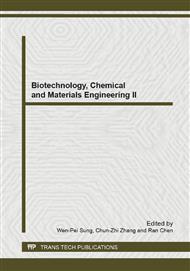p.975
p.979
p.984
p.988
p.993
p.997
p.1001
p.1005
p.1010
The Study in the Toxic Effects of the Material Bisphenol A at Long Time Exposure
Abstract:
Bisphenol a (BPA), is a chemical that has been used for more than 40 years in the manufacture of many hard plastic food containers such as baby bottles and reusable cups and the lining of metal food and beverage cans, including canned liquid infant formula. Therefore, it is very necessary to study its health risk and ecological risk. In this paper, four typical estrogen acceptor genes (AHR1, ESR1, VTG1 and VTG3) in female zebrafish liver were studied to assess the low dose and chronic effects of bisphenol A (BPA), with the method of quantitative real-time RT-PCR, and the ability of self regulation and repair of these genes were also discussed. The results showed that these genes could be induced even at 15 ug/L BPA, and VTG 3 was the most sensitive gene. VTG 3 and VTG 1 had obvious self repair and adjustment ability when BPA risk was removed. No monotonic dose-effect relationships of BPA were also found at this study.
Info:
Periodical:
Pages:
1010-1014
Citation:
Online since:
January 2013
Authors:
Price:
Сopyright:
© 2013 Trans Tech Publications Ltd. All Rights Reserved
Share:
Citation:


